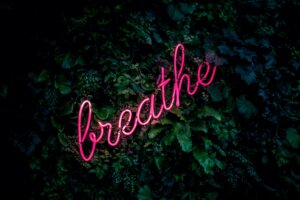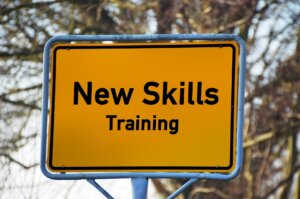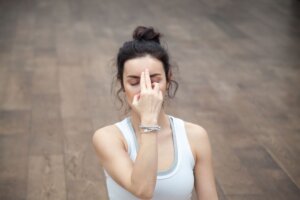We proudly present this guest contribution from Sara Popovic
When I was first diagnosed with depression as a teen, I was considered a weirdo. But as I grew up, something changed. Depression was no longer so unusual and many people shared my story.
The number of depressed people is growing constantly, and today, mental illness is a problem most of us have faced, in one way or another.
Many of us have developed coping strategies after years of struggling. But there are moments when it seems like nothing can help. However, there is something I found always brings me relief – and when I feel good – keeps me in that positive mindset. It is the simple, but incredibly powerful breath work.
Breath directly impacts our health and how we feel. In this article, we will explore exactly how and share specific techniques that can help you to manage your mood and improve your mental health.

How Breathing Affects Mental Health
When we’re caught up in negative emotions, it’s hard to be aware of our breathing patterns. But if you start to observe it – or look someone else – the changes in our patterns become much more obvious. We breathe rapidly when angry and anxious, and sigh when we’re sad. When we are calm, we naturally breathe slowly and deeply.
Our breathing pattern is directly linked to our mood. Let’s take a deeper look in how we breathe when we’re anxious to better understand this concept.

When we inhale we take oxygen, which is used by our bodies and releases carbon dioxide. If our breath is deep, we have a good ratio of oxygen and carbon dioxide in our body and it functions properly.
However, when we’re anxious we breathe more rapidly. Unlike with exercise which uses the additional oxygen to fuel the muscles, we don’t use up the additional oxygen when anxious as we’re not doing any physical work.
This decreases carbon dioxide in the blood. Low carbon dioxide is just as problematic as low oxygen, and creates sensations like tingling, panic and light headiness.
When we return the breathing to its natural state, the levels of carbon dioxide and oxygen are balanced again, and we feel better.
The way we breathe directly impacts the way we feel and vice versa. Deep and slow breathing is a clinically backed way of reducing fear, anger, anxiety, despair and sadness. When we breathe deeply from the belly we feel soothed and calm.
We can deliberately deepen our breathing through breath work.
Breath work simply means you are aware of your breathing. However, we have also developed specific breathing techniques.

Breath work offers an immediate release, but regular practice is more important. By working on our breath every day, we are able to change our patterns and improve our breath – permanently.
Breathing Techniques You Can Use For Mental Health
Let’s go through the specific techniques that can help with stress, anxiety and depression.
Although these techniques are proven to be helpful, we are all different. When you’re just starting to incorporate these breathing exercises, it’s a good idea to try a couple of techniques to find what suits you best. When you find your “match”, work on incorporating it into your daily life.

Deep Breathing
The first technique we are going to talk about is deep or controlled breathing. This simple method is a part of all breathing schools and therapies, as it’s simple and provides instant relief.
Regardless of your experience with breathing methods, deep breathing is a good way to start every breath routine. It’s also a powerful tool to reach for before a panic attack or a stressful situation.
Begin by siting in a comfortable position, on the bed, floor or the chair. Take a few moments to just breathe, not trying to change anything.
Slowly begin turning your focus inward. See where your breath is mainly concentrated – is it the belly or the chest? Visualize how each exhalation removes waste, toxins and negativity from your body, and how each inhale brings new air, freshness and clean energy.
Begin to change the flow of your breath by exhaling completely. Quietly inhale for as long as comfortable. Hold the breath for a second or two, then exhale once more.
Some people find it easier to focus if their count seconds of their breaths. That can help, as this breathing method encourages you to exhale longer than inhaling. A good starting point would be the 2-1-4 scheme. This means you are inhaling for two seconds, holding the breath for a second, and exhale for four seconds. Gradually increase the length, trying to maintain the same ratio.

This breathing technique can calm you down when you are close to experiencing a panic attack, or feel anxious. It relaxes your muscles and slows down the heart rate and it can also energize you when you’re fatigued.
Pranayama
Pranayama is a yogic breathing system, that involves a variety of methods. Here we will list two methods which are most commonly used to calm the stressed mind. These are alternate nostril breathing or Nadi Shodana and Lion’s breath.
Nadi Shodana

Nadi Shodana is a breathing exercise that literally translates to “channel cleansing”. It is a method that cleanses the pathways in your body, on both an energetic and physical level.
Nadi Shodana relaxes the nervous system, brings your mind back to the present moment, boosts concentration, lowers the heart rate and sends more oxygen to the blood. It’s a comforting breath practice that immediately brings a sense of tranquility and safety.
A good way to prepare for Nadi Shodana is to spend some time deepening your breath. When you feel ready, begin your practice by closing one nostril with your thumb.
The hand position used for this exercise is called Vishnu mudra. In this position, your middle and point finger are folded and touch the base of the thumb. The thumb, ring and pinky finger are extended.
Close the right nostril with your thumb, and inhale on the left. Then close the left nostril with your ring and little finger and exhale on the right. Then inhale on the right side, close it and exhale on the left. You are constantly moving through this alternate pattern. While practicing, try to maintain a straight spine and stay aware of everything you do.
Traditionally, you start this practice with 11 rounds, then increase it for 11 more rounds every week until you reach 121 rounds. You can repeat the full practice couple of times per day, and whenever you feel stressed, insecure or struggle with sleeping.
Lion’s Breath
Lion’s Breath is a unique breathing exercise, as it doesn’t only work on your breath, but also stretches the entire face.
Although there is a specific asana that is traditionally done with this Pranayama, you can do it in any comfortable seating position.
Lion’s Breath looks a bit silly, but that can be empowering in itself. It teaches you not to take yourself too seriously, and with time, helps to build your courage and confidence to freely express yourself.
Lion’s breath involves a forceful exhalation from the throat. That strengthens the muscles in your throat but also releases tension and negative emotions we often gather in this area.
This breathing exercise is great when you feel angry, stressed and frustrated. It is an ideal method to release anger, bitterness and other negative emotions. – To do Lions breath, take a deep inhale. Then open your mouth as wide as possible, stuck out your tongue and stretch it downwards, and exhale with a big “ha” sound. This sound contracts the muscles in your throat.
Relax your face with an inhale and repeat for five to ten times. Then finish your practice a couple of deep, slow breaths.
Wim Hof Method

Photo Courtesy of wimhofmethod.com
Wim Hof, also known as the Iceman, is best known for his record-breaking achievements, mainly related to exposure to extreme cold. His impressive physical abilities are a result of a specific breathing method.
Wim Hof has developed his method throughout many years, and is now teaching it to others.
There is a number of scientific studies that researched his method, and they confirmed it has fantastic benefits for our health – including our mental health.
Many people who struggle with insomnia, stress but also clinical depression have reported that Wim Hof method reduced or completely eliminated their symptoms.
The largest scientific proof of the effectiveness of the Wim Hof method for depression is related to inflammation. Scientists have found that inflammation is directly related to depression – and continuous practice of the Wim Hof method is proven to reduce it.
Wim Hof method also helps those who struggle with anxiety. Since we naturally move our breath to superficial chest breathing when we are anxious, taking intentional breaths from the diaphragm signals the brain that you are safe and can relax.
Wim Hof method was built upon old yogic traditions of Pranayama and Tummo, and is based on three pillars: breathing, cold therapy and commitment.
The breathing raises body’s oxygen levels and makes its more alkaline. This boosts the immune response, increases energy and reduces stress.
The cold baths are also an essential part of the method. They can be beneficial for those who are anxious and fearful as they teach you to stay calm in stressful situations. Some researchers also suggest that continuous cold explore releases the nor-epinephrine hormone. This hormone is responsible for attention and mood. When levels of this hormone are low, we have poor mood, feel fatigued and sometimes even get depressed.
This method is advanced and the best way to learn it is through one of Wim’s courses. He has also recently developed a free mobile app with his voice guiding you through the session as well as YouTube videos for beginners. These are the safest ways to learn the method, which involves deep breathing through the mouth and long holds.
The Takeaway
Whether you struggle with a serious mental health condition like clinical depression and panic attacks, or just have a hard time dealing with stress – breath can make you feel better.

Breathing has a direct impact on our feelings. Breathing exercises lower our heart rate, and relax our body and mind. Although they are a good coping skill for instant relief, they also provide long term benefits when practiced consistently. Incorporating a short routine every morning or before sleep may be the best option if you want to permanently reduce negative feelings and bring more confidence, peace and joy to your life.
Sara Popovic is a freelance writer who enjoys writing about fitness, beauty and well-being. When she’s not writing, she’s working out, reading and spending time in nature with their dog.
Contact Sara at saras.content@gmail.com and https://www.fiverr.com/sarascontent


Thank you for the information Sara. I’ve seen you on here before, you always do such a great job at wording things to where they’re easy to understand.
Love the blog!
Wonderful work! This is the type of information that should be shared around the net. Shame on Google for not positioning this post higher! I somehow missed this post when I first discovered this website, I’m glad I went through again. Perhaps a bit of advice- maybe try and organize these articles in a more “user friendly ” manner. Thanks =)
Love this! I tried most of these along with the link to Wim Hoff! I hadn’t heard of him before. I also tried the Nadi Shodana & Lions Breath. I feel like there is more to explore with this being a great start for me because it’s really helped me with anxiety and insomnia! Thank you author!
Smiles xoxo